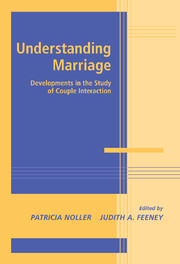Book contents
- Frontmatter
- Contents
- Contribitors
- Introduction
- SECTION ONE THE EFFECT OF COGNITION ON INTERACTION PATTERNS
- Introduction to Section One
- 1 Thought and Action: Connecting Attributions to Behaviors in Married Couples' Interactions
- 2 Self-Evaluation Motives in Close Relationships: A Model of Global Enhancement and Specific Verification
- 3 Competition in Romantic Relationships: Do Partners Build Niches?
- 4 Cognition and Communication during Marital Conflict: How Alcohol Affects Subjective Coding of Interaction in Aggressive and Nonaggressive Couples
- SECTION TWO UNDERSTANDING THE IMPORTANCE OF POSITIVE INTERACTION
- SECTION THREE COPING WITH DISAPPOINTMENT, CRITICISM, AND BETRAYAL
- SECTION FOUR POWER, CONFLICT, AND VIOLENCE IN MARITAL INTERACTION
- Marital interaction at important transition periods
- SECTION SIX Interventions for strengthening relationships
- Conclusions
- Index
Introduction to Section One
Published online by Cambridge University Press: 25 July 2009
- Frontmatter
- Contents
- Contribitors
- Introduction
- SECTION ONE THE EFFECT OF COGNITION ON INTERACTION PATTERNS
- Introduction to Section One
- 1 Thought and Action: Connecting Attributions to Behaviors in Married Couples' Interactions
- 2 Self-Evaluation Motives in Close Relationships: A Model of Global Enhancement and Specific Verification
- 3 Competition in Romantic Relationships: Do Partners Build Niches?
- 4 Cognition and Communication during Marital Conflict: How Alcohol Affects Subjective Coding of Interaction in Aggressive and Nonaggressive Couples
- SECTION TWO UNDERSTANDING THE IMPORTANCE OF POSITIVE INTERACTION
- SECTION THREE COPING WITH DISAPPOINTMENT, CRITICISM, AND BETRAYAL
- SECTION FOUR POWER, CONFLICT, AND VIOLENCE IN MARITAL INTERACTION
- Marital interaction at important transition periods
- SECTION SIX Interventions for strengthening relationships
- Conclusions
- Index
Summary
One feature of the study of marital relationships over the past 20 years has been a focus, not just on couple behaviors, but on the cognitive processes that may drive those behaviors. A wide range of cognitive processes have been studied including appraisals, attributions, beliefs, standards, expectations, rules, perceptions of intention, and subjective interpretations of ongoing interaction. (Some of these cognitive processes are discussed further in the section on coping with disappointment, criticism, and betrayal.) These cognitive processes can be even more powerful than observed behaviors in discriminating between satisfied and dissatisfied couples. The chapters in this section illustrate something of this diversity of cognitive processes and their impact on marital relationships.
Although attributions have been frequently studied by marital researchers, a novel aspect of Manusov's work is its exploration of couples' attributions for their partner's nonverbal behavior, and the effect of these attributions on their own nonverbal behavior. As she notes, one of the intriguing aspects of nonverbal communication is its ability to be interpreted in a myriad of ways. Spouses' interpretations of their partner's nonverbal communication are likely to be affected by many factors including their level of relationship satisfaction. An inno-vative feature of Manusov's work is the recruitment of one member of each couple to act as a confederate who is instructed to use particular kinds of nonverbal behavior in structured interactions with their spouse. This approach ensures that clear examples of positive and neg-ative behavior are displayed by couples, irrespective of marital satis-faction.
- Type
- Chapter
- Information
- Understanding MarriageDevelopments in the Study of Couple Interaction, pp. 9 - 13Publisher: Cambridge University PressPrint publication year: 2002



